NFL Draft Prospect Profile: Chase Young
With the No. 1 overall pick in the 2020 NFL Draft, the Cincinnati Bengals (will probably) select LSU quarterback Joe Burrow. Not long after that, the draft’s consensus top talent – Ohio State defensive end Chase Young – will be chosen.
It’s a familiar refrain in the NFL Draft, which never unfolds in the order of the “best player available.” Even though Young likely won’t be the top choice this year, he’s arguably commanded more attention in the football world than any other prospect in his class, and for good reason.
Young isn’t just the best edge rusher in 2020 – some say he’s the best pass-rushing prospect in years. Pro Football Focus, which has been grading at the college level since 2014, bestowed historic grades to Josh Allen (Kentucky, 2018), Nick Bosa (Ohio State, 2017), Myles Garrett (Texas A&M, 2015), and other elite prospects – Young topped them all in 2019.
Still, you don’t need advanced metrics to see why Young is such a special talent. Evaluators have been drooling over his potential for years, dating back to his days at high school powerhouse DeMatha Catholic. His presence was felt immediately at Ohio State in 2017 and he followed that up with a ten-sack season as a sophomore in 2018. Last year, Young went ballistic: 17 sacks (the most in the FBS), 21 tackles for a loss, and seven forced fumbles…in a season that was cut short by two games, thanks to a suspension over a loan from the draconian NCAA.
Listed at 6’5″ and 265 pounds, Young seems to check every box. He’s powerful against the run and unfathomably smooth as a pass rusher. At Ohio State, Young was the focus of every opposing offensive line, including some of the nation’s most elite units. Frequently, Young was double-teamed, and that didn’t usually work, save for his December matchup against Michigan in which it felt like they double-teamed him on every snap. Even then, the extra attention on Young meant more opportunities for the rest of the front seven, and Ohio State rolled to a 56-27 blowout.
Even evaluators that have put Young under a microscope haven’t been able to find many flaws. Young may have to get more consistent with his pad level and work on his vision, some say. Those critiques are the football equivalent of seeing a supermodel walk down the street and remarking that her nail polish color is tacky. As far as pass-rushing prospects go, Young is as good as they get.
Despite their glaring need at quarterback and unbridled love for Burrow, the Bengals will consider the local phenom for the top pick. At this stage, we’re expecting the Bengals to take Burrow no matter what, but that won’t affect Young much. The Redskins, at No. 2, probably represent Young’s absolute floor.
Prospect Profile: Joe Burrow
The Bengals have roughly three months to figure out who they’ll take with the No. 1 overall pick, but many are convinced that their selection has already been made. Quarterback Joe Burrow, who is coming off of a ridiculous season at LSU, may be a lock for Cincinnati. 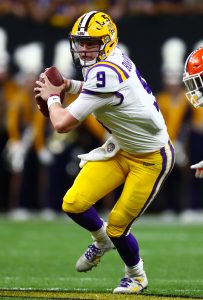
[RELATED: Bengals To Consider Tua, Herbert, Young]
Today, Burrow stands as the consensus top QB in this year’s class. But, in the summer, that wasn’t exactly the case. Scouts long drooled over the potential of Tua Tagovailoa, Justin Herbert, and Jake Fromm while Burrow seemed to be on the tier below. But, thanks to Tagovailoa’s hip injury and Burrow’s meteoric rise, the landscape shifted drastically.
The former Ohio State backup debuted as LSU’s starter in 2018 but threw for only 2,894 yards and 16 touchdown passes as a junior. Then, in 2019, Tigers passing-game coordinator (and new Panthers OC) Joe Brady helped him rise to a whole ‘nother level. Burrow threw for 5,671 yards, 60 touchdowns (!), and lobbed just six interceptions en route to a National Championship and the Heisman trophy.
The numbers have generated headlines, but execs are equally impressed by Burrow’s intangibles.
“Burrow just has it. You can’t coach it; you can’t develop it. Some guys just have it,” one longtime QB coach told Bleacher Report’s Matt Miller in November. “Baker Mayfield has it. Gardner Minshew has it. The difference is that Burrow has better size than both and a much better arm than Minshew.”
There are few knocks on Burrow, but no prospect is perfect. Among the (minor) concerns – Burrow’s limited track record of excellence. A highly-touted prospect out of high school, Burrow found himself mostly buried behind J.T. Barrett and Dwayne Haskins at Ohio State. It wasn’t until 2018 that he got his first crack at starting with LSU, and his numbers didn’t exactly jump off of the page. Then, in 2019, he was unstoppable. Someone playing devil’s advocate with Burrow would probably start here – Burrow’s game tape is excellent, but most of it comes from one season of work.
There’s also the matter of Burrow’s arm strength – he can’t air it out like Herbert and he doesn’t have a Kyle Boller fastball in his arsenal. Still, execs everywhere say that Burrow has the overall makeup to offset those limitations.
The Bengals will do their due diligence on every top prospect in this year’s crop, and they may even listen on trade inquiries, but all signs are pointing to Burrow as the top pick in April.
Prospect Profile: Jake Matthews
If lineage is something to be desired in an NFL draft prospect, Texas A&M offensive tackle Jake Matthews has that contest won. The 22-year-old is the son of Hall of Famer Bruce Matthews, who played 19 seasons with the Oilers/Titans, the cousin of current NFL linebackers Clay and Casey Matthews, and the brother of Kevin Matthews, who has spent time with the Titans and the Redskins.
But even without his storied family history, Matthews’ own talent and development would make him a surefire top 10 draft selection. After being named a 2009 USA Today high school All-American, Matthews entered Texas A&M, and was plugged in on the Aggies’ offensive line, where he played started 33 games over his first three seasons (mostly at right tackle). In 2013, following the departure of incumbent left tackle Luke Joeckel (the third overall pick by the Jaguars), Matthews moved to blind side and protected quarterback Johnny Manziel for all 13 games. In addition to being selected as a consensus All-American last season, Matthews was named to the All-SEC team in both 2012 and 2013.
At 6’5″, 305 pounds, the former Aggie is large enough to handle stout defensive lineman, but also has the agility to ward off quicker outside linebackers. When compared to Joeckel, Matthews grades out as slower, but he does have the advantage in power. Sound technique is the foundation of Matthews’ game, and that proficiency, combined with his size, allows him to simply maul in the run-blocking game. His physical traits aside, Matthews’ intangibles are off the charts — he was a team captain at Texas A&M, obviously has the pedigree, reportedly scored a 32 on the Wonderlic test, and scouts are said to be highly impressed with both his awareness on the field and his leadership off it. A prototypical franchise left tackle, Matthews has the ability to “walk in and play left tackle and sit there for 10, 12 years,” as one scout told the Milwaukee Journal Sentinel’s Bob McGinn.
Matthews, of course, also has his detractors and his limitations. Another scout told McGinn that Matthews’ surname might be clouding evaluators’ opinions: “If his last name was something else, I don’t think he’d be picked as high.” Physically, others believe that his arm length of 33 3/8″ might be too short, limiting his extension. Like Joeckel, Matthews is sometimes accused of lacking a “killer instinct” (however, that demerit didn’t seem to hurt Joeckel’s stock). Finally, some point to his prowess as a right tackle and believe he would be a better fit on that side of the line, which would obviously degrade his value.
It is difficult to find a team that wouldn’t be interested in Matthews, as most franchises could use a left tackle of his caliber, and if not, at least an upgrade at right tackle. The Texans will probably go in another direction, and while the Rams could be interested in an offensive lineman, most reports have Greg Robinson as the higher rated player and the favorite to go second overall. The Jaguars could re-pair him with Joeckel, but the first real possibility is probably the Browns at No. 4, who would immediately install Matthews at right tackle. Within the top 10 selections, the Raiders, Falcons, Buccaneers, Bills, and Lions are all possible landing spots for Matthews. Along with Robinson and Taylor Lewan, Matthews is part of a triumvirate of offensive tackles that will all likely be top 10 picks.
Photo courtesy of USA Sports Images.
Prospect Profile: Chris Borland
Although our series of prospect profiles thus far has focused primarily on players projected to go in the first round, Wisconsin linebacker Chris Borland has been receiving a good deal of attention in the press as of late, so we thought it might make sense to explore what he has to offer. Indeed, for teams that are looking for a quality Day 2 option, Borland could represent a perfect fit.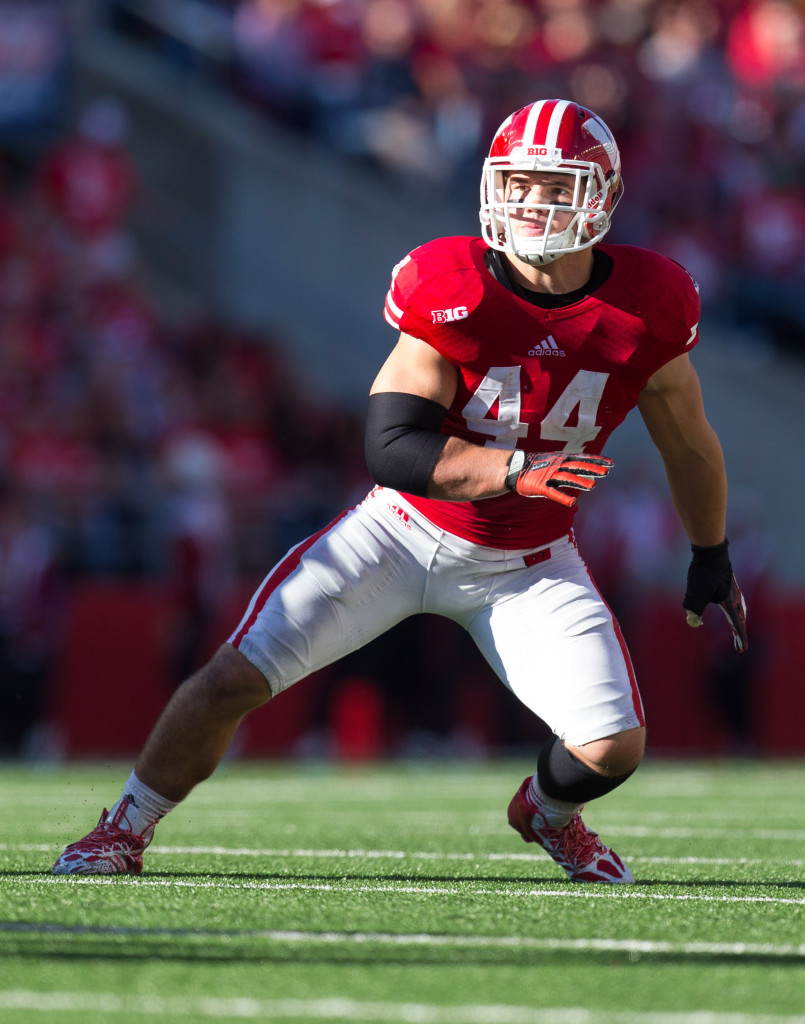
Greg Gabriel of the National Football Post gives a fairly comprehensive view of Borland’s strengths and weaknesses. For instance, Borland had a very productive collegiate career, especially in 2013, when he accumulated 112 tackles, 8.5 tackles for loss, and four sacks as Wisconsin’s “Will” linebacker. Borland also excels at the mental part of the game, as he has terrific instincts and is an effective blitzer. Also, what he lacks in speed he makes up for in his ability to read routes well and in his pass drop, which allows him to be useful in zone coverage.
However, because he does have averaged timed speed, he will struggle in man coverage. Also, he is only 5’11” and has very short arms, which means he will miss some tackles. Gabriel calls Borland a “classic overachiever,” and although he lacks ideal size and speed, he is explosive in short areas and has good change-of-direction abilities, making him an effective run-stopper. Essentially, if you can live with a few missed tackles and can pair him with a speedy linebacker who can cover receivers downfield, Borland could make a good deal of sense. His intelligence will also be a tremendous asset in the middle of any team’s defense.
Arjuna Ramgopal of WEEI.com offers similar insights as Gabriel, noting that Borland has drawn favorable comparisons to long-time Dolphins stalwart Zach Thomas. He adds that Borland is effective at diagnosing plays and is a sure tackler. Combining Ramgopal’s analysis with Gabriel’s, it seems that as long as Borland can reach you with his short arms, you will probably go down.
As far as his pedigree, Borland is as good as it gets. He was 2013 Big Ten Defensive Player of the Year, 2013 Big Ten Linebacker of the Year, 2013 first-team All-American, 2013, 2012, 2011 first team All-Big Ten, and 2009 Big Ten Freshman of the Year. Because of that pedigree, his production, and his dedication, John McMullen of the Merced Sun-Star labeled Borland a “safe” pick and calls him a “can’t-miss contributor.”
His one injury concern arose in 2010, when Borland injured his left shoulder and missed all but two games. Bob McGinn of the Milwaukee Journal Sentinel writes that the injury has forced one team to take Borland off its draft board entirely, as that team’s physicians believe the shoulder would require additional surgery.
That concern, of course, could drop Borland’s stock on draft day. But assuming he is physically cleared to play, the team that drafts him will get a bruising, savvy playmaker who is effective against the run, effective enough in coverage, and who plays every down with the intensity required of his position.
Photo courtesy of USA Today Sports Images.
Prospect Profile: Calvin Pryor
If Alabama’s Ha Ha Clinton Dix is not the top safety in this draft, then Louisville’s Calvin Pryor is. While nominally these two players inhabit the same position on the field, the two free safeties have very different styles of play. While we already examined the playmaking ability in the center field that Dix could bring to the table, Pryor counters with the big-hitting, in-your-face style of play of safeties past.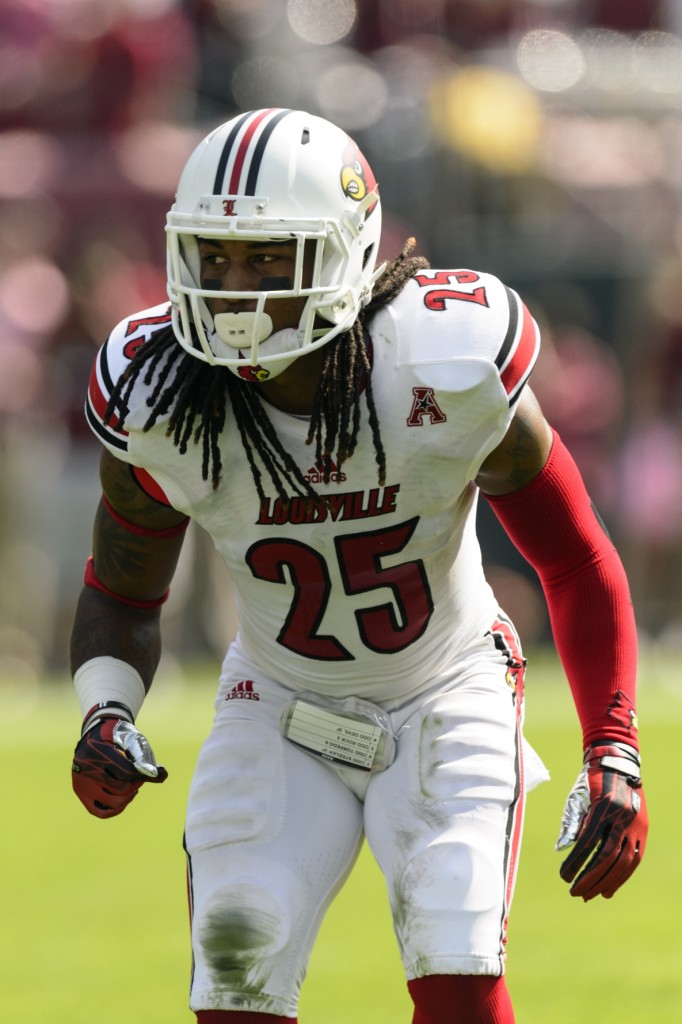
Pryor’s biggest strength on the football field is violence. He struck fear in the hearts of any receiver running a crossing route in front of him. His highlight clips on YouTube are among the most fun watches of any prospect, filled with big plays that look as if they were scripted to elicit groans from all who watch. He throws his body into every play with full force and no hesitation. His dedication to those highlight hits makes him a weapon as a run defender. For an insight into his physical dominance, he had a stretch in which he knocked an opponent out of a game in three consecutive games, according to NFL.com.
While most fans will probably remember him for his ability to put ball carriers on the ground, Pryor never proved to be a weakness covering the middle of the field. It was rare to find him in man coverage, but he was able to cover deep in the middle of the field, exhibiting good range. His athleticism is not dissimilar to that of Clinton-Dix, as Pryor weighed in at 207 pounds and posted an identical time of 4.58 in the 40-yard dash. Pryor did measure in at 5’11”, a full two inches shorter than Clinton-Dix.
Pryor’s aggressiveness can be his greatest weakness on tape, as expected for a player always going for the big hit. He has the tendency to overrun plays, leaving himself susceptible to the cutback. He might take some bad angles, and a big hitter always risk the chance of missing on a tackle, especially as he meets bigger and stronger runners in the NFL.
Still, for a safety not known as a ballhawk, Pryor managed to get his hands on seven passes in his three years at Louisville, with a few highlight catches among those. He also forced nine devastating fumbles for his career, solidifying himself as one of the biggest hitters in college football regardless of position. Pryor was named Second Team All-Big East as a sophomore, and after a conference change, achieved First Team All-ACC as a junior before declaring for the NFL Draft. Like his counterpart from Alabama, Pryor was suspended for violating a team rule, forcing him to miss a game during his final collegiate season.
Early in the draft process, a common thought was that Pryor could be too physical for the NFL game. Pundits worried that he was almost a guarantee for fines and suspensions, a potential magnet for defenseless receiver calls. For the most part, that thinking corrected itself, and coincided with Pryor’s rise up draft boards. While most still have him as the second best safety in this class, he has closed the gap between himself and Clinton-Dix. Both ESPN’s Mel Kiper, Jr. and Todd McShay have Pryor falling to the Cowboys (No. 16) (subscription required), while two out of the four mock drafts posted by CBS Sports have him up at No. 13, to the Rams. The Louisville hammer also has some traction among the Bears (No. 14) and Ravens (No.17).
Photo courtesy of USA Today Sports Images.
Prospect Profile: Ha Ha Clinton-Dix
Earl Thomas signed a huge extension on Monday, making him the highest paid safety in the NFL. The reason Thomas got that money is due to the rarity of true to form center field type safety in today’s game. The versatility that a speedy defensive back that can play in the middle of the defense, providing coverage skills as well as strength bringing down the ball carrier makes a defensive coordinator’s job much easier. If not easier, then definitely more fun.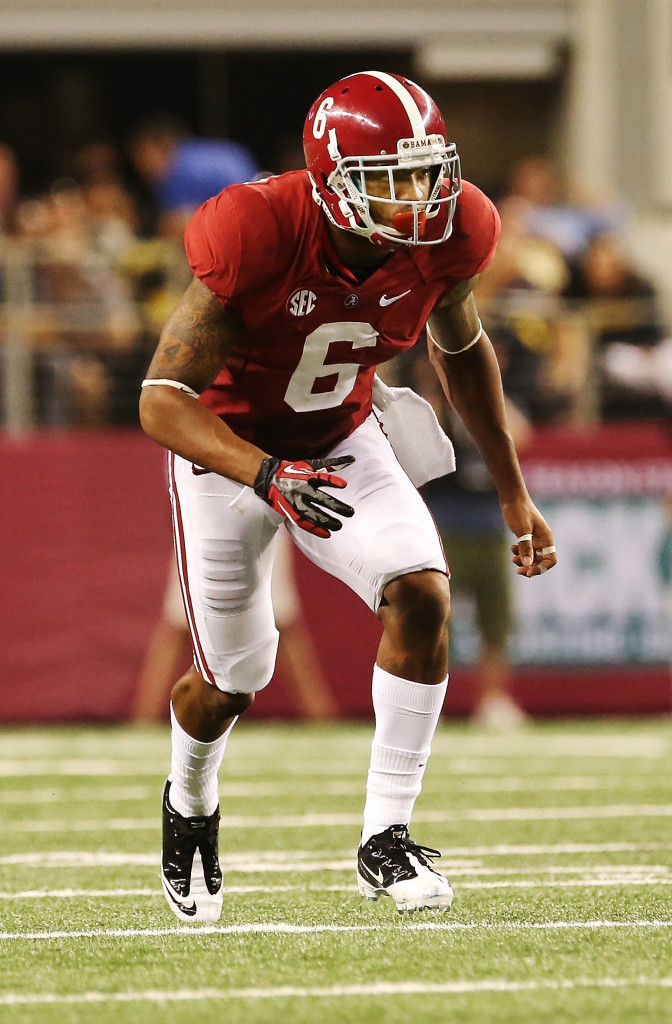
There is only one safety in the mold of Thomas projected to be picked in the first round of the upcoming NFL Draft, and that is Alabama’s Ha Ha Clinton-Dix. Dix played three seasons with the Crimson Tide, and was a part of two national championship teams. His five interceptions as a sophomore led a highly regarded Alabama defense. Clinton-Dix was suspended for two games during the 2013 season, due to “unspecified team rules violations.” Despite missing two games, he was named First Team All-SEC after his junior season, and was a Consensus All-American safety.
Clinton-Dix measured out well at the NFL combine, standing tall at 6’1″ and 208 pounds. He ran a respectable 4.58 40-yard dash. It does not put him in the category of elite athletes, but it is a combination of size and speed that is desirable in a prospect. Under Nick Saban, he learned how to play the position efficiently. According to NFL.com, he is quick to read and react to plays, and makes up for his average speed by taking great angles to the football, where he becomes a nightmare due to his good ball skills and ability to turn defense into offense.
Like many Saban coached defensive backs, Clinton-Dix shined in college coming up to stop the run. Not one to shy from contact, he gets into the alley and is a strong open field tackler. While he does not have the top speed to run with the fastest receivers in the NFL, nor the bulk to be considered a true in the box safety, he does provide versatility in his ability to switch from a run stopper to a pass defender from play to play.
Safety is a tough position to gauge in regards to this draft. Clinton-Dix is not the clear cut top option, as Louisville’s Calvin Pryor has been making headway. The two are very different players as well, as Clinton-Dix has the reputation for staying in the middle of the field and making plays on the ball, whereas Pryor is known as the big hitter. Style will play a huge role in which player comes off the board first.
Clinton-Dix starts to gain a lot of traction among mock drafts starting with the Lions (No. 10). If the Lions pass on him, he begins to make a lot of sense for the Rams (No. 13) and the Bears (No. 14). ESPN’s Mel Kiper, Jr. agrees that the Rams could jump on him, and Todd McShay has him landing in St. Louis as well (subscription required). The Vikings (No. 8) seem like the highest he could possibly go, and if the Steelers (No. 15) do pass, the Cowboys (No. 16), Ravens (No. 17), and Jets (No. 18) all have significant need at safety.
Photo courtesy of USA Today Sports Images.
Prospect Profile Series
Leading up to the 2014 draft, Pro Football Rumors is taking a closer look at some of the top prospects in this year’s draft class in Prospect Profile pieces. We’re evaluating a number of players’ stocks, breaking down their pros and cons, and forecasting where they may land in next week’s draft.
We’ve got another handful of Prospect Profile posts on the way, but for now, you can catch up on the ones we’ve published so far. This list will continue to be updated up until draft night, and can be found at any time on the right-hand sidebar under “PFR Features.”
- Chris Borland (LB, Wisconsin)
- Blake Bortles (QB, UCF)
- Teddy Bridgewater (QB, Louisville)
- Ha Ha Clinton-Dix (S, Alabama)
- Jadeveon Clowney (DE, South Carolina)
- Mike Evans (WR, Texas A&M)
- Khalil Mack (OLB, Buffalo)
- Jake Matthews (OT, Texas A&M)
- Calvin Pryor (S, Louisville)
- Sammy Watkins (WR, Clemson)
Prospect Profile: Khalil Mack
The University at Buffalo has produced NFL players before, but (with all due respect to James Starks and Trevor Scott) Khalil Mack is set to enter the league as the most acclaimed Bull in school history, with his talent and seemingly endless potential likely making him a top-five selection in next month’s draft.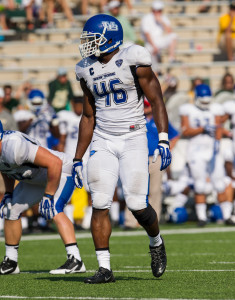
Graded as just a two-star recruit coming out of high school, Mack has always played with something of a chip on his shoulder. In the 2009 version of EA Sports’ NCAA Football, he was given an overall rating of only 46 (out of possible 99), making him one of the worst players in the game. Mack used this slight as motivation, choosing 46 as his jersey number throughout his dominating college years.
And dominate he did. In 2013, Mack’s second straight season as a Butkus Award finalist, he registered 100 tackles, 10.5 sacks, three interceptions, and five forced fumbles. The edge rusher was named the Mid-American Conference’s Defensive Player of the Year, and a second-team All-American. He set a NCAA record with 16 career forced fumbles, and finished tied for first in career tackles for loss (75).
Explosiveness is the key to Mack’s game — his vertical jump is an astounding 40 inches, and his first-step quickness from the outside linebacker position is unparallelled in this draft. He rarely gets pancaked by opposing offensive lineman, and any OL trying to block Mack one-on-one, especially at the second level, will face severe difficulty. The 23-year-old is a master of many pass-rushing maneuvers, but the outside move is his specialty, as his almost flawless technique allows him to leave offensive tackles off-balance. Additionally, Mack has the speed, exhibited by a 4.65 40-yard-dash, to drop in pass coverage and, with a bit more experience, could be a nice weapon against physical tight ends running seam routes between the hash marks.
The primary concern for Mack, like most prospects from small schools, is the level of competition he faced. The MAC is certainly not the SEC, and it is not even comparable to the Pac-12 or the Big 12. However, Mack, in something of a coming-out party, did perform extraordinary well against Big 10 powerhouse Ohio State, showing that he can hang with elevated competition. Analysts have also noted that Mack has the tendency to play with reckless abandon at times instead of relying on his sound technique, indicating that harnessing his skill will be a critical test at the next level.
Mack, at 6’3″ and 251 pounds, could fit a multitude of defensive schemes — he probably makes the most sense as a 3-4 outside linebacker, but could also play OLB in a 4-3, or even, in a pinch, as a 4-3 defensive end. He is a dark horse candidate to go No. 1 overall to the Texans, as some believe that he is a better fit than Jadeveon Clowney for Houston’s 3-4 defense. The Jaguars, owners of the third pick, are looking for a pass rusher to stabilize their front seven, and teams like the Raiders, Falcons, Vikings, and Bills could all be interested in the dynamic edge player. Along with Clowney, Sammy Watkins, and Greg Robinson, Mack is considered one of the elite players in next month’s draft, and it would be surprising to see him fall out of the top five selections.
Photo courtesy of USA Today Sports Images.
Prospect Profile: Jadeveon Clowney
Coming out of high school, Jadeveon Clowney was the number one recruit in his senior class. He was the best defensive player in college football at his best. Now he is the best bet to be the number one overall pick in the 2014 NFL Draft.
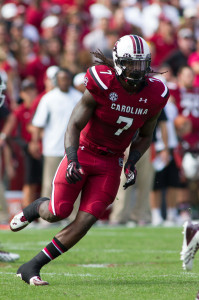
A player of Clowney’s status could not come easy. It started early, when he famously decided to hold out on his college acceptance decision until after National Signing Day, electing to instead announce his decision live on ESPN, on Valentine’s Day, which doubled as his 18th birthday. He chose South Carolina and his hometown Gamecocks over the more highly touted programs among the SEC and ACC.aft. He was the number one recruit coming out of high school in 2011, and has basically been anointed as a certainty ever since, although his recruitment had earned him the label of a “diva” in the eyes of the media, which would be the first knock on him as a future NFL star.
Then the domination began. Clowney more than lived up to the hype during his first two seasons in Columbia, South Carolina. He posted 8.0 sacks and five forced fumbles as a freshman for a South Carolina team that went 11-2. That season he had the luxury of following the lead of another pass rushing standout in Melvin Ingram, who wound up as a first-round pick to the Chargers in the following draft. As a sophomore, Clowney was able to take all the spotlight. His 13.0 sacks left him as the most feared pass rusher in the nation, and solidified him as a very high draft pick, with most scouts noting the he would have been the first overall pick had he been eligible for the 2013 NFL Draft.
Controversy came again that offseason, as many NFL experts and media personalities noted that Clowney had nothing to gain by returning to school. He would risk a career debilitating injury, but could not raise his draft stock at all. Sports radio and NFL shows discussed whether it would be more beneficial to him if he were to skip school and workout full time, as he would have been basically ensured a spot in the top five if he was not still drafted first overall a year later.
Clowney did return to school, but battled through injuries and inconsistent effort until once again, his merits as a prospect were questioned. He missed two games entirely, and ended up with statistics that fell short of previous numbers. Still in play for the first pick, his case was not as rock solid as it had been a year earlier, especially as the Texans, Jaguars, Browns, and Raiders possessed huge needs elsewhere on offense, particularly at quarterback and receiver. The Rams, set at quarterback, already own a dynamic pass rushing duo of Robert Quinn and Chris Long. Clowney would truly have to impress to stay in the top five.
Of course, that is exactly what Clowney did at the NFL Combine in Indianapolis. He measured in at a large 6’6″, weighing a lean 266 pounds with 34.5 inch arms and ten inch hands. Then he took that giant frame for a run, posting a blazing 4.53 40-yard dash, with extremely impressive numbers across the board in the other drills as well.
Even still, not everyone is sold on Clowney. Greg Cosell called him a “raw” athlete, and stated that he believes pass rusher Khalil Mack should be rated as the top player in the draft at that position.
Hall of Fame defensive lineman and Fox Sports analyst Warren Sapp was also critical of Clowney, saying, “I look at Jadeveon Clowney’s (game) tape and I don’t see a guy that is playing with his hair on fire, making plays, running up and down the field sideline to sideline, doing all of the things.”
ESPN analyst Merril Hoge, who played running back for the Steelers, was even harsher of Clowney as a football player. “You look at him as a fundamental football player when you talk about feet, hip and hands, like we watch Khlail Mack, he’s actually atrocious,” he said. “Clowney as a football player is not very good. Amazing athlete. Don’t get confused by being an athlete and being a good football player. Not a very good football player.”
Even his peers took shots at him, notably when Auburn defensive end Dee Ford declared himself the better option for teams looking for a pass rusher. “I’m better. Let’s put it like this. People like to talk about size all the time. Size is pretty much overrated in my eyes,” said Ford. “You can look at guys like Robert Mathis, Elvis Dumervil, Von Miller. These are 6-2 guys and under. People are just looking at the fact that he is a physical specimen. Honestly if you watch the film, he plays like a blind dog in a meat market basically.”
Despite those who are no longer sold on Clowney’s ability, he still has a good chance of going first in this draft, and is seemingly a lock for the top three in one of the most wide open drafts in a while. CBS Sports has all four major mock drafts currently with Clowney as the first player off the board (three to the Texans, one projecting the Falcons trading up). NFL.com posts eight mock drafts, of which six have Clowney going first, with Bortles taking the top spot in the other two. From ESPN, both Mel Kiper, Jr. and Todd McShay have Clowney atop their most recent mocks. We won’t know until that first name is called on May 8th, but star or bust, or somewhere in between, some people are going to be very wrong on this divisive yet incredible NFL prospect.
Prospect Profile: Teddy Bridgewater
The quarterback position is the number one priority for a handful of teams drafting in the top ten. The Texans, Jaguars, Browns, Raiders, Buccaneers, and Vikings could all use huge upgrades at the position, and all will most likely have the opportunity to select one of the top three or four quarterback prospects.
Even though there is such a tremendous need at the top of the draft, that does not guarantee that those quarterbacks will be coming off the board early. Part of that is the lack of consensus among the top quarterbacks. Zach Links already looked at the current favorite to be the top quarterback taken in UCF’s Blake Bortles, but the original star of this quarterback class was Louisville’s Teddy Bridgewater. (For what it’s worth, Johnny Manziel also spent some time on the top of those big boards.)
Bridgewater stands tall enough between 6’2″ and 6’3″ depending on who you ask, but his slight frame leaves much to be desired. He certainly lacks the massive size of Bortles, but makes up for it with his own strengths. Bridgewater was a three year starter at Louisville before leaving after his junior season. Had he been allowed to leave after his sophomore season, he would have likely been the first quarterback off the board, ahead of both E.J. Manuel and Geno Smith. Thought of as “NFL ready” due to his quick release, poise in the pocket, and ability to quickly scan and read defenses, there were moments in time when it was a foregone conclusion that Bridgewater and Jadeveon Clowney would be drafted first and second overall, in some order.
Of course, throughout the draft process Bridgewater’s stock has dropped off. Bortles of course has passed him due to his prototypical size, and Manziel shot out of a rocket and has become such a love him or hate him prospect, it seems every team has either put him at the top of their wish list or taken him off their board altogether. Bridgewater struggled with accuracy and mechanics at his pro day, establishing red flags that made scouts and pundits question why they thought he was so “NFL ready” to begin with.
His play on the field is still impressive. He completed almost 69% of his passes as a sophomore, and improved that number to 71% as a junior. In those last two years, he posted 28 and 31 touchdowns against 7 and 4 interceptions, respectively. Bridgewater was often calm under pressure, and handled blitzes and pass rushers effectively and efficiently.
Draft expert Mike Mayock of NFL.com has downgraded Bridgewater out of his first-round projection.
“I’ve never seen a top-level quarterback in the last 10 years have a bad pro day, until Teddy Bridgewater. He had no accuracy, the ball came out funny, the arm strength wasn’t there, and it made me question everything I saw on tape because this was live. I went back and watched a bunch more tape and compared him to the rest of the guys in the draft,” said Mayock. “And like it or not, I’ve come to a conclusion — if I was a GM in the NFL, I would not take him in the first round of the draft.”
Not everyone has given up on Bridgewater completely. While he has clearly fallen behind Bortles as an option for the Texans (No. 1), Jaguars (No. 3), and Browns (No. 4), mock drafts still put him as high as the Buccaneers (No. 7) and Vikings (No. 8). Even for those who see him falling fast, there has been a narrative that see the Browns selecting one of the elite defensive players or a receiver such as Sammy Watkins with their first pick, and catching Bridgewater or possibly Derek Carr with the pick they received in the Trent Richardson deal with the Colts (No. 26).
